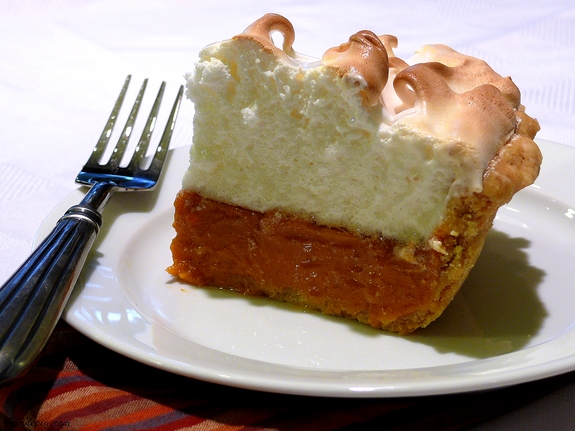Sweet potatoes are essentially the closest you’ll get to pumpkin in both taste and consistency. With ingredients and spices similar to that of a pumpkin pie, it’s the perfect alternative to the fall classic. Factor in the rich and fluffy marshmallow meringue, and you have an utterly delectable treat in your hands..
So check this out-
INGREDIENTS:
| 1 cup | all-purpose flour (sifted) | ||||||||||||||||||||||||||||||
| ½ teaspoon | salt | ||||||||||||||||||||||||||||||
| ⅓ cup | shortening (+1 Tablespoon) | ||||||||||||||||||||||||||||||
| 2 tablespoons | ice cold water | ||||||||||||||||||||||||||||||
| 3 | large sweet potatoes (to make 2 cups of filling, do not use canned) | ||||||||||||||||||||||||||||||
| 4 | egg yolks (from large eggs) | ||||||||||||||||||||||||||||||
| ¾ cup | sugar | ||||||||||||||||||||||||||||||
| ¼ cup | brown sugar (lightly packed) | ||||||||||||||||||||||||||||||
| ¼ cup | evaporated milk | ||||||||||||||||||||||||||||||
| 1 tablespoon | fresh lemon juice | ||||||||||||||||||||||||||||||
| 1 teaspoon | vanilla extract | ||||||||||||||||||||||||||||||
| 1 teaspoon | ground cinnamon | ||||||||||||||||||||||||||||||
| ½ teaspoon | kosher salt | ||||||||||||||||||||||||||||||
| ¼ teaspoon | ground nutmeg | ||||||||||||||||||||||||||||||
| 1 | lemon (zest of) |
3 ½ cups marshmallow creme
DIRECTIONS:
For the pie crust, measure flour into bowl; mix salt through it. With pastry blender (or two knives) cut in shortening until particles are the size of giant peas. Sprinkle with cold water, a Tablespoon at a time, mixing lightly with fork, until all flour is moistened.
Here is my trick. No matter what crust I use, it never seems to roll out as large as I want, so I increase the recipe by about half (it doesn’t even need to be exact). This gives me extra dough on the edges for a thicker crust and I often have enough left over to make little cut outs as well. This crust recipe is for an 8″ or 9″ pie, but with the increase, it fits my 9″ deep dish pan, which is what I used to make this pie. It’s up to you whether you increase the recipe for the dough or not.
Gather dough together with fingers so it cleans the bowl. Press firmly into a ball. Then turn out lightly on a board covered with wax paper and lightly floured to prevent sticking.
Prepare your rolling pin by covering it with a stockinet. If you do not have a stockinet, you must get one. It will make your crust endeavors so much easier. Flatten the disc with your hand and roll out the dough to about 1/8″ thick. Keep rounding the pastry edge. If it begins to break, pinch broken edges together the best you can. Keep pastry circular and roll it about 1″ larger all around than an inverted pie pan.
Fold pastry in half and carefully transfer to your pie pan. Unfold and ease pastry loosely into pan. Do not stretch which causes shrinking during baking.
Fold the edges under and crimp as desired. Preheat oven to 400 degrees.
Place pie shell in the freezer for 15 minutes or until firm. Line frozen shell with foil, pressing firmly against the sides and folding gently over the edges. Fill shell with raw rice or dried beans and blind bake until crust is set but not browned, about 20 minutes. Unfold foil at edges and carefully lift it out; return shell to oven and bake 5-10 minutes, or until pale golden.
For the filling, bake sweet potatoes for 40-50 minutes or until very soft in a 400 degree oven. Peel while hot and place potatoes in food processor.
Puree until smooth. Peeling and processing the potatoes while hot makes a smoother puree.
Add egg yolks, sugars, milk, lemon juice, vanilla, spices and lemon zest; whisk just to blend. Pour filling into pie crust (it’s alright if the crust is still hot from baking…if you are using a store bought crust, make sure it’s at least room temperature), smooth the top and bake 20 minutes at 400 degrees. Reduce oven to 325 degrees and continue baking until a knife inserted 1″ from the center comes out clean, 20-30 minutes. Remove pie but leave oven on.
Beat room temperature egg whites (you can do this and have it ready while pie is baking) with a mixer in a clean metal or glass bowl until soft peaks form. Gradually add marshmallow creme and continue beating until stiff peaks form, 5-7 minutes more.
Spread meringue over pie all the way to edges so the meringue doesn’t shrink. (Beads of liquid often form on meringue. To avoid “weeping” spread the meringue on the pie while the filling is hot, then brown it.) Spike it to make swirls and swoops. Return pie to the oven and bake 15-20 minutes or until topping is golden, rotating for even browning. Watch the pie carefully at this point, do not walk away…meringue can burn.
Cool pie to room temperature and place in the fridge over night before serving.

And there you have it...Enjoy! Eat well my friends!



No comments:
Post a Comment